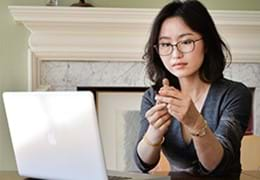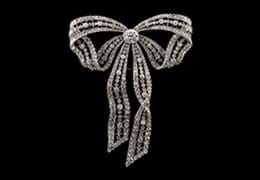Style Spotlight | Kate Pearce | Parnham Park: A Modern Grand Tour on the Jurassic Coast
In anticipation of Dreweatts' eagerly awaited upcoming auction on 13 May 2025 - Parnham Park: A Modern Grand Tour on the Jurassic Coast - which showcases the eclectic collection of James Perkins, Dreweatts spoke with popular New York-based designer Kate Pearce. She elaborated on how she goes about looking for original and unusual antiques and furniture that tell a story for her designs and asked her to choose five favourite pieces from the auction.
Kate Pearce Vintage was originally founded in 2017 to support Kate’s pre-medical tuition during a period of serious health struggles. Realising she needed a career with greater flexibility, Kate ultimately transitioned away from the medical field and towards retail. The business began on Etsy and grew through Instagram, gaining recognition when Apartment Therapy featured her home in 2018. Now, Kate focuses on DIY and interior design, while managing a family and ongoing renovations. In 2021, she completed a renovation of a 1910 farmhouse and is currently working on a new 1899 home in Chicago.

What types of items are you drawn to when shopping at an auction?
The pieces that pique my interest the most at auction are the ones that are most unique to the owner of the estate being auctioned, or the pieces that are rare, personal, or more difficult to find via other vintage and antique resources. I love that auctions often provide more history and information about a piece than if you were to come across the same piece in an antique shop, or an estate sale, and I find that information to be particularly valuable, especially when they are one-of-a-kind pieces that may be more difficult to research. Auctions will often arm you with provenance and details that are imperative for valuation and resale, but it also makes the pieces more personally valuable as a part of your collection. When someone asks you about the piece, instead of saying, “oh I found that on the shelf of a thrift store,” you’ll have a much more interesting story to tell. This also makes the piece more personally valuable since these objects don’t just become another piece to layer in a room, but also carry with them a sense of history.

What are some of your tips for finding antiques and vintage pieces to create unique interiors?
My biggest tip is to diversify your sources. I shop for antiques and vintage pieces at flea markets, thrift stores, estate sales, auctions (both online and in-person), vintage and antique stores (also, both online and in-person), Facebook Marketplace, architectural salvage spots, and a favourite way to purchase antique and vintage pieces is through my favourite sellers on social media. Over the years, I’ve been able to connect with some wonderful one-person dealers who sell exclusively through their social media handles, and I often find the most unique and interesting pieces through them (and often for great prices, too, as they don’t have the same reach as the larger powerhouses in the field). My second biggest tip is to frequent these spots often. The best pieces, especially if they are priced competitively, don’t last. So really the only way to regularly score great pieces and great prices is to be on the search as often as possible. This has been made much more accessible to everyone in recent years with the advent of an incredibly vast selection of vintage and antique resources online.
How do you incorporate antiques and interesting finds into your projects?
I can’t imagine ever designing a room without layering in those older pieces that really bring the soul to a space. I do think, however, it is also important to layer in some newer pieces to keep these designs feeling fresh and modern. I usually follow the 70/30 rule: 70% older pieces, layered with 30% new (this isn’t a “true” rule, it’s only one I have invented as guidance for myself). I often love buying antique or vintage furniture with interesting silhouettes, and then upholstering them in a fresh fabric. Rugs are always better when they’re old, and adding in some pieces with patina is also a must. I find the smaller decorative objects that make a space feel complete are nearly always best being antiques/vintage, too. I buy both new and old art, but one way I often make newer art pieces feel “at home” with my older pieces is by framing them in antique frames.

How important do you think it is to mix antique and vintage pieces when designing a home versus buying everything brand new?
I think it’s incredibly important for so many reasons. The first, and most important, reason being that antique and vintage pieces come with a story behind them, and their age is exactly what brings soul and interest to a room. I think people are often turned off by antiques that aren’t in “perfect” condition, but I would argue that it’s exactly their imperfections that make them more alluring. Of course, structural or major damage is one thing, but things like the hand-carved turns to a barley twist table leg (versus a manufactured one), or copper cookware that wash and-hammered versus machine-made. I also love (as many collectors do) the thrill of the hunt. I have so many wild and interesting stories from over the years about how I have acquired certain pieces, or even just the history behind them, all of which becomes wonderful fodder for jump starting a conversation with guests.
The Parnham Park auction has many special and unique natural history highlights including a mammoth skeleton, ammonites, corals and a large amethyst cluster. What are some thoughtful ways to integrate historically significant pieces into a space with more contemporary design elements? What are some creative ways to incorporate natural elements into an interior?
There are so many ways to incorporate pieces from the natural world and/or historically significant pieces, such as the ones highlighted in the Parnham Park auction. I love the pieces that incorporate natural elements with practical design (such as the shell encrusted table I chose as one of my favourites from the auction). Still, not everything needs to have a practical purpose in a space, and layering in purely decorative objects is exactly what gives a room dimension and interest. These larger pieces (such as the mammoth skeleton, or the large amethyst cluster) can easily serve as sculptural elements (and great conversation pieces). The smaller corals and items would be wonderful styled on a bookshelf or a coffee table. An other item I loved from the auction was the Louis Vuitton trunk converted into a coffee table, which leaves a wonderful opportunity (in the centre of the table) to display one of these organic pieces. I always say that it is tension that creates interest in rooms, and juxtaposing what is perhaps the epitome of luxury design (the Louis Vuitton trunk) with a piece that is thoroughly unmanufactured (such as a piece of coral, or a fossil), is such an unexpected combination that will certainly spark conversation and create an aesthetic dialogue that will pique the viewer’s interest.

View page turning catalogue
Auction Details
Auction: Tuesday 13 May, 10.30am BST
Auction venue: Dreweatts Donnington Priory, Newbury, Berkshire RG14 2JE, England
Viewing venue: Parnham Park, Beaminster, Dorset DT8 3LZ, England
Browse the auction
Sign up to email alerts
VIEWING: Viewing at Parnham Park, Dorset | Entrance with catalogue only (admits two)
Friday 9 May: 10.30am-5pm
Saturday 10 May: 10.30am-5pm
Sunday 11 May: 10.30am-5pm
Monday 12 May: 10.30am-5pm
CATALOGUE: To purchase a printed catalogue, please visit our Catalogue Subscriptions page.
BIDDING:
Bidding is available online, in person at Dreweatts, by telephone or you can leave commission (absentee) bids. To learn more including details on registering to bid, payment and shipping, click here. To register to bid, click here.
FURTHER INFORMATION:
General enquiries: + 44 (0) 1635 553 553 | housesales@dreweatts.com
Press enquiries: press@dreweatts.com



















